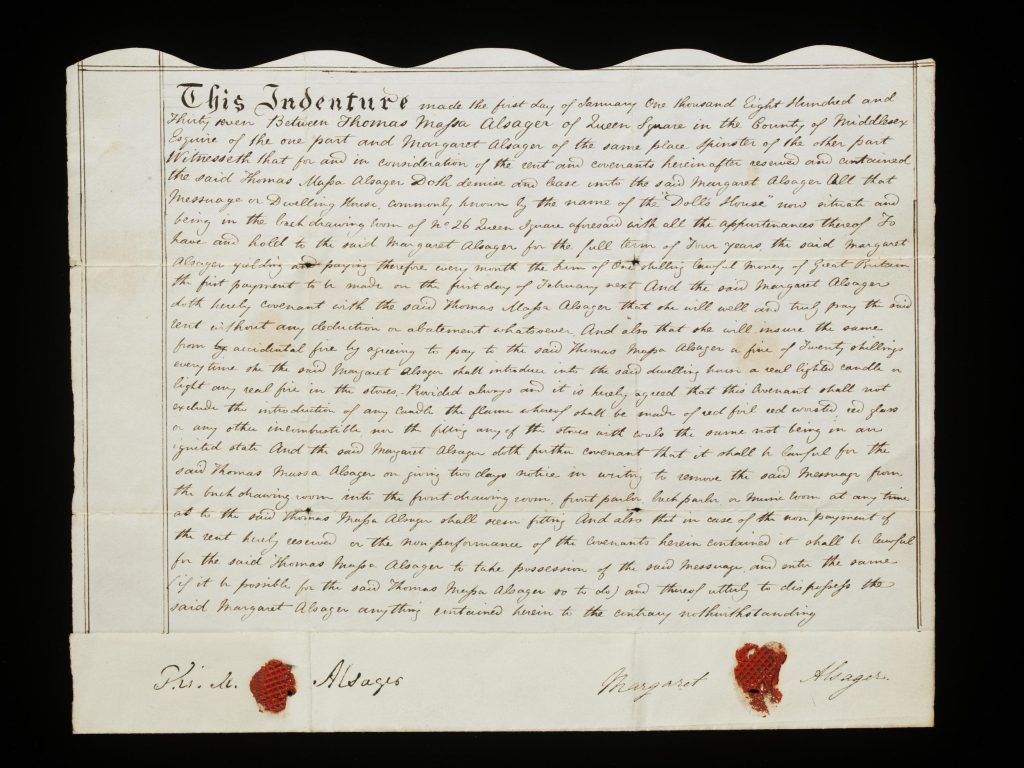
“Indenture‚” by Mr. Thomas Massa Alsager (1779-1846), 1837. Copyright Victoria and Albert Museum, London (Museum of Childhood).
This has to be one of the most unusual dollhouse artifacts I have ever seen.
You read me right. This rather unusual document is about a girl and her dollhouse. Written in 1837, it is a contract between Mr. Thomas Massa Alsager, a journalist from Queen’s Square in London, and his eldest daughter, Margaret, who was then just 12 years old. The contract details the care of Margaret’s doll house, and places it firmly in the family’s parlour – one of the most public rooms of the house. It suggests that not only was Margaret’s dollhouse actively played with, it was displayed for all of the family’s guests to see and admire. Margaret wasn’t a small child hidden away in the nursery; instead, she was as public a figure as her parents.
The contract also spells out what Margaret’s rights and responsibilities were for the dollhouse. Each month, she had to pay “the sum of one shilling lawful money of Great Britain” in rent to her father. She also had to insure the dollhouse “from accidental fire by agreeing to pay to the said Thomas Massa Alsager a fine of twenty shillings every time she, the said Margaret Alsager, shall introduce into the said dwelling house a real lighted candle or light any real fires in the stove” (I wonder how many fires happened before that tidbit was needed!). If Margaret failed to keep her end of the contract, her father would take away the dollhouse.
This is awesome because it shows that a young Victorian girl had real agency – enough to even sign her name on a contract!
Now, while some may say it was just for play, the terms of this contract are legally binding. And we know that the Alsager family entertained often, since Thomas was the self-taught co-editor of the Times, chair of the Clothworker’s Company, and founder of the Beethoven Quartet Society (which also included figures like John Keats and Charles Lamb). So it’s likely that Thomas talked about his contract with Margaret, or even let her tell the terms to their guests.
What Margaret might not have known is that dollhouses have been around ever since Ancient Egyptian times. In fact, several dollhouses have been found in Egyptian tombs of the Old Kingdom, dating to over 5,000 years ago. Dollhouses are a long tradition, with the modern ones rooted in 16th century Europe (though those were hand-built displays meant for wealthy adults, not children). By Margaret’s time, dollhouses had become a commodity and toy, with Germany leading the way in their manufacture.
Yet Margaret led the way in their status. Her contract contradicts all we know about quiet, proper Victorian girls. Margaret was a fire-lighting young girl whose rights and responsibilities were clearly claimed in the eyes of the law.
It makes you wonder if that fiery spirit would someday lead her to become a suffragette…
-Tiffany Rhoades
Program Developer
Girl Museum Inc.
This post is part of our 52 Objects in the History of Girlhood exhibition. Each week during 2017, we explore a historical object and its relation to girls’ history. Stay tuned to discover the incredible history of girls, and be sure to visit the complete exhibition to discover the integral role girls have played since the dawn of time.
